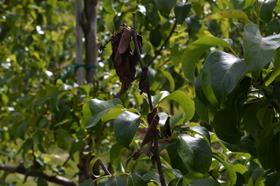
Mild weather has caused levels of fireblight in apples and pears to double in the past year, making bacterial diseases some of the most problematic facing growers in 2016, the Royal Horticultural Society has revealed.
Bacterial diseases now rank as the eighth biggest plant health concern for growers to contend with, based on figures from the RHS. In 2015 they did not feature in the top ten list.
In the past twelve months the organisation dealt with roughly 50 per cent more inquiries related to bacterial diseases such as fireblight, which kills the shoots of apple and pear trees and their ornamental relatives. This makes the plant look like it has been scorched by fire.
Symptoms of fireblight include the wilting and dying of blossoms at flowering time and, as the infection spreads down the inner bark of the plant, shoots shrivel and die. Blossoms and fruit can also be attacked, and the vigour of the plant reduced as a result of premature defoliation, according to the RHS.
Speaking about the results, RHS head of plant health Gerard Clover said: “Dealing with pests and diseases is an integral part of gardening and always has been, however gardeners are not powerless against the threats posed by pests and diseases.
“Simple steps such as choosing more resistant varieties and taking an integrated approach to dealing with them, which could involve using a combination of controls together such as biological and cultural, can help gardeners fight back.”
As with all bacterial diseases, there is no cure for fireblight and no chemical controls are available for combating the disease.
The only way that it can be controlled is by pruning out and burning infections promptly and wiping pruning tools with disinfectant between cuts to avoid spreading the bacteria.
Hawthorn bushes should also be avoided by commercial fruit growers as these can be a source of infection, according to the RHS.
Other problems highlighted in the organisation’s list of top plant pests and diseases for 2016 were: scab diseases, with the RHS recording 65 per cent more enquiries; slugs and snails, which topped the list with a record number of recorded instances; honey fungus, which was named as the most troublesome plant disease; and glasshouse thrips and fuchsia gall mite, which became much more problematic in 2016 compared to 2015.
Fuchsia gall mite moved five places up the table from 8th in 2015 to 3rd in 2016. Glasshouse thrips had an even more spectacular rise, moving from outside the top 10 in 2015 to 4th place last year.



